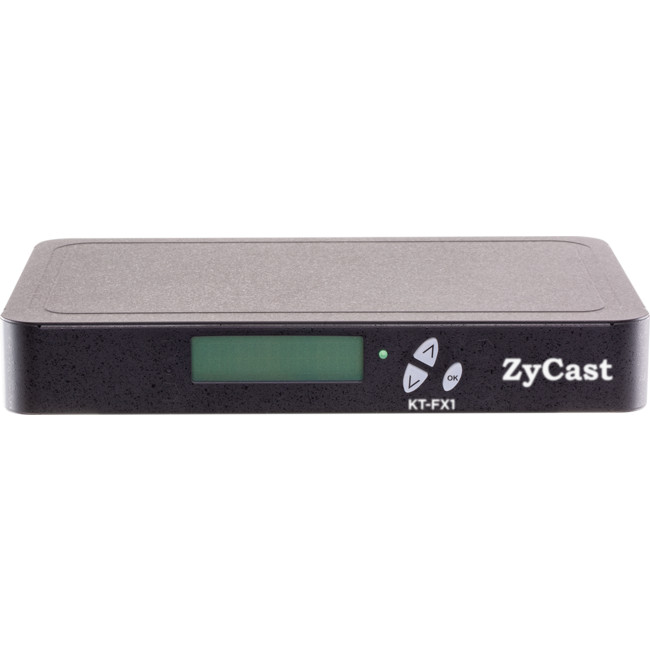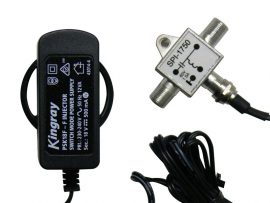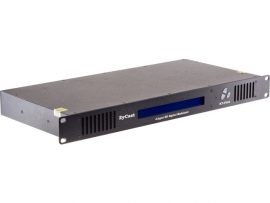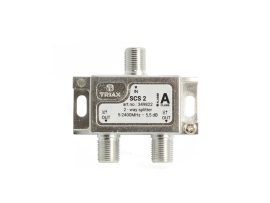Description
ZyCast KT-FX1 HDMI ModulatorZyCast KT-FX1 HDMI Modulator Foxtel Approved
The ZyCast KT-FX1 HDMI Modulator is a Foxtel-approved single input (HDMI) HD digital modulator that encodes HDMI signal to any DTV channel.
Pre-programmed with a Foxtel-approved channel listing andwith an output level of 90dB and MER of >38dB, theKT-FX1 makes use of video compression via H.264 AVC (MPEG-4) and audio compression via MPEG Layer II/AAC to distribute a crystal-clear HD picture over new or existing coaxial cable.
Programming of the ZyCast KT-FX1 HDMI Modulator is done via a web GUI and front LCD panel. It uses a frequency range of 177.5MHz to 816.5MHz (6 to 69).
Specifications
General
KT-FX1
Foxtel Approved NumberF31059
Input
Number of inputs: 1
Video input: HDMI
Video input level: 0.7 – 1.4V (Peak to Peak)
Video mode: PAL
Audio input: Stereo
Audio input level: 0.4 to 4.8V (Peak to Peak)
Output
Frequency Range:: 177.5 MHz to 816.5 MHz (6 to 69)
HDMI loop through: No
Output level: 85dB
MER>38dB
Delayed audio output :No
Connection type: F Type
Modulation
Video Resolution: 480i, 480p, 576i, 576p, 720p, 1080i, 1080p
Video compression: H.264 AVC (MPEG-4)
Audio compression: MPEG Layer II / AAC
Video bitrate SD: 1Mbps to 9Mbps (Default 5Mbps)
Video bitrate HD: 12Mbps to 24Mbps (Default 24Mbps)
LCN: AU (APN)
Carrier: 2K / 8K
GI:1/32
FEC:7/8
Constellations: 16 QAM / 64 QAM
Management / Programming
Front LCD: Yes
Web GUI: Yes
Power supply: 12VDC 1.5AMP External
Operating temperature: 0c to +45c
Storage temperature: -0c to +60c
Dimensions: 236mm x 145mm x 34mm
Weight: 0.88kg
Warranty 3 years
For the Zycast Q4K-R1 HDMI Modulator with 4K Loop out, please follow this link
What’s the difference between MPEG2 and MPEG4
DVB-T (Digital Video Broadcasting – Terrestrial) is a standard for transmitting digital television signals over terrestrial (over-the-air) broadcast networks. MPEG-2 and MPEG-4 are video compression standards used in DVB-T to encode the video content.
- DVB-T MPEG-2: DVB-T MPEG-2 refers to the use of the MPEG-2 video compression standard within the DVB-T system. MPEG-2 is an older compression standard that was widely used for digital television broadcasting before the introduction of MPEG-4. It offers moderate compression efficiency, which means it requires more bandwidth to transmit video compared to MPEG-4 for the same quality. MPEG-2 provides good video quality, especially for standard definition (SD) content, and it is still compatible with many older television sets and receivers.
- DVB-T MPEG-4: DVB-T MPEG-4, on the other hand, uses the more advanced MPEG-4 video compression standard. MPEG-4 offers better compression efficiency, allowing broadcasters to transmit higher quality video using less bandwidth compared to MPEG-2. This is especially beneficial for high-definition (HD) and other bandwidth-intensive content. MPEG-4 can deliver superior video quality with the same amount of data or equivalent video quality with less data compared to MPEG-2. However, MPEG-4 requires more processing power for encoding and decoding, which means older television sets or receivers may not support MPEG-4 without a compatible decoder.
In summary, the main difference between DVB-T MPEG-2 and DVB-T MPEG-4 lies in the video compression standard used. MPEG-2 is an older standard with moderate compression efficiency but good compatibility with older devices, while MPEG-4 is a more advanced standard offering better compression efficiency for higher quality video but requiring more processing power and compatibility considerations.
How can I tell if my TV is MPEG2 or MPEG4
Early Digital TVs sold in Australia had MPEG2 DVBT Tuners. Later models have progressed to MPEG4. Any MPEG4 TV is backward compatible and will also work with MPEG2 signals. However MPEG2 TVs will not work with MPEG4 signals incuding those from MPEG4 modulators.
It is often difficult to see from the TV’s specifications if the hardware is MPEG2 or MPEG4. The easiest way is to test the TV with a normal broadcast antenna signal. New HD Channels such as Channel 70 (7HD) or Channel 31 (SBS Viceland HD) are broadcast in MPEG4. If you TV produces a black picture or an error message such as FORMAT NOT SUPPORTED, then this TV is MPEG2 only.
To correct a MPEG2 only TV, a new DVBT Set top box can be used to tune the RF signal and convert it to a HDMI input on the TV.









